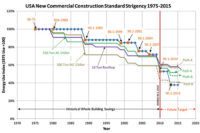For several years, the HVACR industry has seen new technologies come to market that have dramatically improved the way buildings utilize energy. And as these energy-efficient technologies continue to prove their value, they are increasing in use and becoming more cost-favorable. Today, there is a wave of emerging technologies and trends that are converging with energy-efficiency efforts and simultaneously uncovering and igniting a dramatic and influential trigger point to change. Looking ahead, if the U.S. building stock continues to require less energy from the electric grid to operate, and the grid continues to face a growing set of complex challenges, including greater peak-load demands, the country could be on the tipping point of a potential transformation in building energy efficiency and the role of the electric utility in serving commercial buildings.
Emerging Technologies

|
| Robert Wilkins |
Energy already has become a core theme and focus of the industry, including manufacturers, contractors, and engineers alike, and a growing number of new construction and retrofit buildings are being designed to consume energy more resourcefully.
Technologies like variable-speed air conditioning, combined heat and power (CHP), and solar and wind power are drastically improving building energy use. Variable-speed technology improves a system’s energy efficiency over a full-year cycle by continuously and more precisely matching heating and cooling output to the load. Plus, it provides important peak-load benefits and demand response capabilities that help utilities reduce electricity demand on the days they experience extreme loads, and it features low starting in-rush current, which reduces the need for a robust utility connection.
CHP systems, which convert waste heat into useful heat for water heating or other applications, are becoming more economically viable — especially the micro CHP systems suitable for small buildings and apartment complexes. And the steadily decreasing cost of solar and wind power technologies also is making on-site generation of renewable energy a cost-effective method of slashing a building’s electricity bill and lessening its full dependence on the local utility.
The potential of these technologies reaches new heights when we consider the increasing practicality of thermal and battery storage, which can help to enable solar photovoltaic (PV) generation and demand response capabilities. In emergency situations, backup power generators, now lower in cost, also are more accessible to individual building owners, as well as smaller, more reliable, and — by not requiring diesel fuel — cleaner. The benefits only further multiply when clusters of buildings or communities operate as a micro-grid, sharing mutually the benefits of advanced, energy-efficient systems and reducing waste.
These technologies compound the impact of building envelope upgrades, LED lighting, and other high-efficiency lighting strategies and fenestration practices that already work to reduce the total energy load of a building. As a building’s electrical load decreases, and its reliance on the power grid is offset by the expanding genset and CHP technologies, the reliance on traditional utility generation decreases.
Parallel Trends Converge
While energy-efficiency measures will continue to drive much of the demand for such intelligent technologies and systems that reduce consumption, there also is a developing nationwide focus on electricity demand, particularly as the U.S. electric grid faces concerns about capacity and reliable distribution. An aging infrastructure, affected by population growth and demand for energy, is causing peak-load issues for many utilities across the country, which consequently increases, in part, the cost of electricity generation and distribution at the expense of reliability.
Often, to meet peak-load demand, older power plants are brought online, which ignites concerns about environmental health and protection. Historically, coal-fired power plants were constructed at a distance from residential areas because of their huge footprint — a coal rail yard or docks and a storage yard, as well as the sulfuric smell and residue emitted from the plants.
And, as a result of their locations, there is no practical use for the plant’s thermal energy by-product and so only one-third of the energy produced is transformed into electricity and transported to its point of use. The other two-thirds either goes up the stack or into a neighboring river as waste heat. This level of inefficiency, combined with the rising price of coal and growing concerns about climate change, is putting economic and regulatory pressure on coal-fired plants and fostering widespread conversion from coal to gas.
The trigger point to change, therefore, lies in the natural gas supplies that have been unearthed and made abundant by hydraulic fracturing, or fracking. As a cleaner fossil fuel, natural gas provides several benefits. Since electricity generation is cleaner, it can be moved closer to the point of use, often within the city or even within a building itself, which dramatically increases efficiency. Plus, unlike electricity, natural gas can be stored to manage peak loads or periods of interrupted generation from solar and wind.
Combined with the advancements in technology that are reducing and reshaping building load profiles, and also making onsite generation and storage possible, comparatively low-cost and more environmentally friendly natural gas is framing on the horizon a viable alternative to central utility generation.
Distributed Generation
According to the U.S. Department of Energy’s (DOE’s) Office of Energy Efficiency and Renewable Energy, “75 percent of U.S. buildings will be new or renovated by 2035.” This presents a tremendous opportunity not only for high-efficiency and load-reducing technologies, but also for distributed generation (DG) systems, which live near or at the point of energy consumption. Together, natural gas gensets, CHP systems, rooftop solar arrays, storage systems, and other similar technologies present economic and efficiency benefits that could shift buildings and building clusters/campuses away from the grid and into a largely independent state.
Nevertheless, designing and constructing buildings with DG systems is a complex undertaking — particularly in retrofit situations, where a complete building overhaul must be done to ensure structural efficiency, including building envelope and lighting. DG also is more attractive to certain types of installations than others, such as buildings or campuses with a large thermal load, where, for example, CHP can help significantly improve the efficiency of heating large amounts of water for areas like food preparation/service and laundry. Therefore, hospitals, hotels, schools/universities, and military bases — which use both high levels of cooling and hot water — could reap the greatest benefits, particularly in regions where electric rates and demand are high.
The advantage for buildings is evident: DG systems can help avoid unexpected — and sometimes dangerous — electricity downtimes. But, these systems also positively impact the grid by reducing the amount of load fluctuations, thus improving stability.
If DG systems were to become a widespread alternative to centralized generation, the traditional role of the electric utility and the method by which buildings are designed and built would, necessarily, change. Commercial buildings would rely less on utilities for generation and transmission, causing utilities to become smaller and serve, instead, as backup electricity providers. The decreased cost of electricity also could shift how building owners and managers allocate funds for new technologies and services.
Though this emerging phenomenon is not yet a commonplace approach, the industry should not look the other way, but instead prepare for and anticipate the dramatic changes that could result from the convergence of these trends.
For HVACR, the number of installations of advanced, high-efficiency, intelligent technologies would only increase when DG systems are utilized, requiring contractors and technicians to be intimately familiar with their installation, service, and maintenance to ensure building performance and energy reliability. Implications also exist for building controls systems, as sophisticated controls would be required to meld all building functions into one reliable control point, likely with mobile access. And, perhaps most importantly, would be the demand on the industry to be able to maintain individual systems at design specifications so that they operate as expected within the greater system.
Today’s high-efficiency technologies are not only helping to reduce energy use in buildings, but also enable better communication between building systems and the electric grid. But the future of building efficiency and building power seems to hinge on the influence of today’s natural gas supplies and prices, and the various technologies that make onsite generation a cost-effective, productive, reliable, and efficient alternative for buildings and communities. The elements of change are emerging and aligning themselves, but the path forward would still require the broad deployment of technology, a holistic approach to building system design, and the attention of building-related industries.
Publication date: 4/14/2014
Want more HVAC industry news and information? Join The NEWS on Facebook, Twitter, and LinkedIn today!










